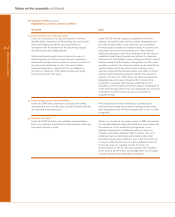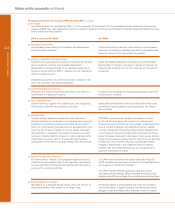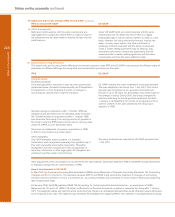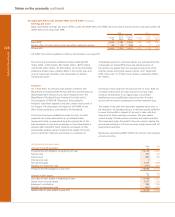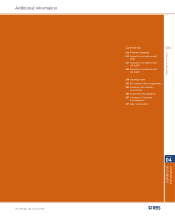RBS 2005 Annual Report Download - page 224
Download and view the complete annual report
Please find page 224 of the 2005 RBS annual report below. You can navigate through the pages in the report by either clicking on the pages listed below, or by using the keyword search tool below to find specific information within the annual report.
222
Notes on the accounts
Notes on the accounts continued
IFRS
(f) Long-term assurance business
IFRS requires bancassurance contracts to be analysed
between insurance and investment contracts. Investment
contracts are accounted for as financial instruments. Insurance
contracts are accounted for using an embedded value
methodology: the shareholders’ interest in the long-term
assurance fund is valued as the discounted value of the cash
flows expected to be generated from in-force policies together
with net assets in excess of the statutory liabilities.
(g) Financial instruments
Financial assets designated as at fair value through profit or loss
Under IFRS, a financial asset may be designated as at fair
value through profit or loss on initial recognition.
Debt securities classified as loans and receivables
Non-derivative financial assets with fixed or determinable
repayments that are not quoted in an active market are
classified as loans and receivables except those that are
classified as held-to-maturity, held-for-trading, available-for-sale
or designated as at fair value through profit or loss. Loans and
receivables are initially recognised at fair value plus directly
related transaction costs. They are subsequently measured at
adjusted cost using the effective interest method less any
impairment losses. The Group has classified some debt
securities as loans and receivables.
Financial assets other than debt securities and equity shares
classified as available-for-sale
Under IAS 39 financial assets classified as available-for-sale
may take any legal form.
Foreign exchange gains and losses on monetary available-for-
sale financial assets
For the purposes of recognising foreign exchange gains and
losses, a monetary available-for-sale financial asset is treated
as if it were carried at amortised cost in the foreign currency.
Accordingly, for such financial assets, exchange differences
resulting from retranslating amortised cost are recognised in
profit or loss.
Financial liabilities
All financial liabilities held-for-trading are classified as such
and carried at fair value with changes in fair value recognised
in net income. A financial liability may be designated as at fair
value through profit or loss.
US GAAP
US GAAP also requires bancassurance contracts to be
classified either as insurance or investment contracts; however
US GAAP does not permit embedded value reporting.
US GAAP requires deferred acquisition cost and income
accounting for all contracts. Where investment contract policy
charges benefit future periods, they are deferred and
amortised.
Such designation is not allowed under US GAAP.
Under US GAAP, these debt securities are classified as
available-for-sale securities with unrealised gains and losses
reported in a separate component of equity, except when the
unrealised loss is considered other than temporary in which
case the loss is included in net income.
Under US GAAP, only debt and equity securities can be
classified as available-for-sale. (Such securities are measured
at fair value with unrealised gains and losses reported in a
separate component of equity).
Such differences are included with other unrealised gains and
losses and reported in a separate component of equity.
Only financial liabilities that are derivatives and short positions
are carried at fair value with changes in fair value recognised
in net income.
46 Significant differences between IFRS and US GAAP (continued)


